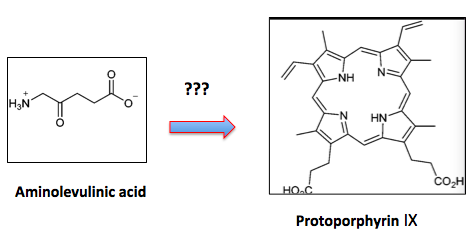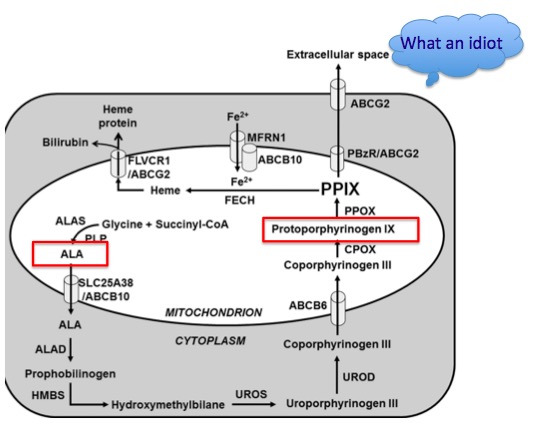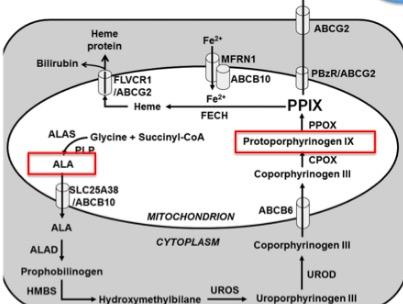It took 20 years, but a group of scientists south of the border has found a cure for the most prevalent infection that is found "south of the border." Eva Ramon Gallegos and colleagues at the National School of Biological Sciences in Mexico City have found a way to kill human papillomavirus (HPV) (1) the most common sexually transmitted infection (STI) using light. Depending on the severity of infection and the presence or absence of skin lesions, the therapy eliminated between 57.2% and 100% of the virus in infected women.
PHOTODYNAMIC THERAPY
This was not accomplished with a 100 Watt bulb; it was done using a technique called photodynamic therapy (2): a laser, an endogenous non-protogenic (3) amino acid called aminolevulinic acid, and some very clever science. Chemistry explains the rest. More or less.
Photodynamic therapy depends upon the ability of a chemical to absorb light (especially laser light) and generate energy, which then promotes a chemical reaction to kill cancer cells. But aminolevulinic acid, the chemical that was applied to the cervix, is not a photosensitizer. It doesn't do anything when you shine a light on it. Instead, it acts as a pro-drug - an inactive compound that is converted by the body to an active drug (4). The active drug derived from aminolevulinic acid is called protoporphyrin IX, and it readily absorbs light. Here's the chemical transformation that needs to take place to form protoporphyrin IX. It is not trivial.

EVEN CHEMISTRY HAS LIMITS
Organic chemists are trained to carry out reactions that convert one chemical substance into a different one using a chemical reaction (or a series of them). But we can only do so much. The structure of aminolevulinic acid is completely different from that of protoporphyrin IX, so it is reasonable to assume that this conversion is going to be a living nightmare. Hence, it is unwise to give this assignment to an organic chemist.

Fortunately, mitochondria do not hang themselves. Nor do they have any problem converting aminolevulinic acid to protoporphyrin IX...

Mitochondrial biosynthesis of aminolevulinic acid to protoporphyrin IX. Source: Journal of Pharmacology and Experimental Therapeutics
TREATING HPV WITH PHOTODYNAMIC THERAPY
Here's how it works.
- The aminolevulinic acid is applied to the cervix where it is selectively taken up by cancer cells.
- After about four hours protoporphyrin IX is formed inside the cells.
- The cancer cells are now photosensitivitized; they are able to respond to light.
- The affected area is irradiated with a laser which penetrates the cells in the cervix.
- The protoporphyrin IX inside the cancer cells absorbs energy from laser light, which causes it to form an "excited state" - a transient high energy form of the molecule.
- Excited state protoporphyrin IX is unstable; it reacts with molecule oxygen forming a highly reactive, short-lived form of oxygen called singlet oxygen.
- Singlet oxygen, which is highly toxic, kills the cancer cells.
Healthy cells, which have not taken up protoporphyrin IX are unaffected by the laser, which accounts for the selectivity - something that is very important in cancer treatment. The more selective the therapy, the fewer side effects can be expected.
THE RESULTS
A total of 449 Mexican women participated in the study. All were infected with HPV; some had no precancerous lesions, others had lesions, or had lesions but no active infection.
- In the group of women who were infected by HPV but no lesions were present, the virus was eradicated in all of the women.
- In the group of women who were infected by HPV and also had lesions, the virus was eradicated in 64% of the women.
- In the group of women who had lesions but no active infection, the virus was eradicated in 57% of the women.
- No damage to healthy tissue was observed.
HPV is the most common sexually transmitted infection. More than 22% of the US population has been infected, resulting in 6,100 cancer deaths per year. A simple, non-invasive method of getting rid of the virus could represent a significant advance in public health.
Nice job.
NOTES:
(1) Of the 100+ strains of HPV, 14 are considered to carry a high risk of cancer. Although three HPV vaccines have been approved, only Gardasil® nine which covers the nine riskiest strains; it is 88% effective in preventing genital warts, vulvar and vaginal precancerous lesions, cervical precancerous lesions, and HPV-related cervical cancers. (Source: Henry J. Kaiser Family Foundation)
(2) Photodynamic therapy is not new. It has been used to treat a variety of cancers.
(3) There are a bazillion amino acids out there, many of which are necessary for life, but not all amino acids are incorporated into proteins. DNA uses only 20 amino acids to make all our proteins. Non-protogenic is a fancy word for amino acids which are not part of proteins.
(4) See ADHD Sufferers—Pay Attention: Here's How Vyvanse Works




